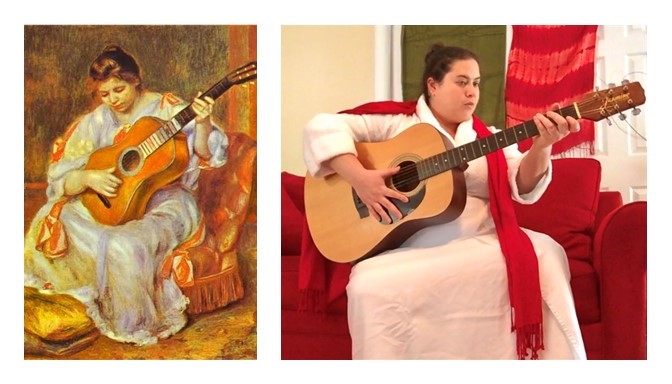Today’s positive psychology exercise continues two themes from earlier in the week:
- Promoting playfulness.
- Providing research evidence for the benefits of current viral trends.
In our last exercise, you learned about some of the ways in which music can promote well-being (and might have enhanced your own well-being by incorporating some of your favorite music and lyrics into your new handwashing routines). Today, we’ll turn to another area of the arts: visual art. Much of the empirical literature investigating the relationship between the visual arts and well-being has focused on the potential benefits of creating artwork. Art therapy, which promotes well-being through art-making and creative processes, has been found to reduce symptoms and improve well-being in both clinical and non-clinical populations. There is also evidence that engaging with artwork as a viewer – both in-person (as in museum settings) and digitally – can promote well-being and other positive outcomes. For example, museum visitors experienced a reduction in anxiety after viewing artwork, and “receptive arts engagement” (such as visiting museums and attending concerts or theater performances) appears to be protective against loneliness among older adults.
Today’s exercise combines both of these approaches to visual art – viewing and engaging with existing artworks, and exercising your own creativity through re-creating one of these works with what you have at home. I’ve shared my own attempt below, and I would love to see yours!
Today’s Positive Psychology Exercise: Take the #MuseumChallenge
Over the past few weeks, various museums have encouraged people to recreate famous works of art from home, most notably the “Getty Museum Challenge,” which was inspired by the Rijksmuseum and “Between Art and Quarantine.” The challenge is simple:
- Choose your favorite artwork.
- Find three things lying around your house.
- Recreate the artwork with those items.
You can see examples of others’ creations at this Getty blog post, the “Between Art and Quarantine” Instagram account, and this Buzzfeed article. My own attempt, based on Pierre-Auguste Renoir’s Woman Playing a Guitar, is below!

The Science
Tyack, C., Camic, P. M., & Heron, M. J. (2017). Viewing art on a tablet computer: A well-being intervention for people with dementia and their caregivers. Journal of Applied Gerontology, 36(7), 864-894. https://doi.org/10.1177/0733464815617287
Background: Art-based interventions have been shown to be beneficial for the well-being of people with dementia and their caregivers. This article explored whether such interventions can be delivered via a touchscreen tablet device displaying art images.
Method: Twelve pairs of volunteers with dementia and informal caregivers were recruited (N = 24). A quasi-experimental mixed-methods within-subjects study evaluated the well-being impacts of art viewing using visual analogue scales and explored participant experiences with thematic analysis.
Findings: Quantitative results before Bonferroni correction showed a significant effect for change in composite well-being from Session 1 to Session 5 but this became non-significant after the correction was applied. Well-being subdomains generally increased with number of sessions. Qualitative findings included changes in cognition, behavior, mood, and relationships. These changes tended to be viewed positively.
Conclusion: The results suggest touchscreen-based art interventions could yield well-being benefits for this population. A larger-scale controlled study would help determine whether wider dementia care practice implications can be drawn.